Sustainable Mobility Matters—Summer 2023
This quarterly newsletter highlights recent projects, partnerships, and publications related to NREL's sustainable mobility research.
Subscribe to receive this newsletter via email.
NREL Analysis Delivers Actionable Insights To Drive Transportation Decarbonization Decisions
With transportation as one of the highest-emitting sectors worldwide, finding ways to swiftly lower emissions is a climate conundrum that has captured the attention of nations on a global scale. No stranger to taking on challenges, researchers at the National Renewable Energy Laboratory (NREL) are leveraging decades of expertise in transportation analysis—including its world-class data modeling and high-performance computing capabilities—to design road maps to reach transportation decarbonization goals at the state, federal, and global levels.
In fact, plans for the United States' national electric vehicle (EV) charging networking are being shaped by NREL's The 2030 National Charging Network: Estimating U.S. Light-Duty Demand for Electric Vehicle Charging Infrastructure. This seminal study assesses the number, type, and location of EV chargers that will be needed to create a comprehensive charging network that can support an anticipated 30–42 million EVs on U.S. roads by 2030.
NREL's expertise is also gaining global reach. NREL's partnership with the U.S. Agency for International Development builds tools that empower and support partners in other countries to reach their ambitious climate and energy goals. The video, Sustainable Transportation Capabilities and Impacts of the USAID-NREL Partnership, tells the story of how NREL researchers built customized tools to guide implementation of EV infrastructure in Bogota, Colombia. Importantly, the effort took steps to bake equity into the energy transition in rural and indigenous communities, resulting in increased EV adoption in Bogota and lower emissions throughout the country.
Both projects are addressing the environmental and social impacts of transportation across entire countries, helping to advance the reduction of transportation emissions globally. What course will we chart next? The possibilities are endless.
Drive on,
Chris Gearhart
Director, NREL's Center for Integrated Mobility Sciences
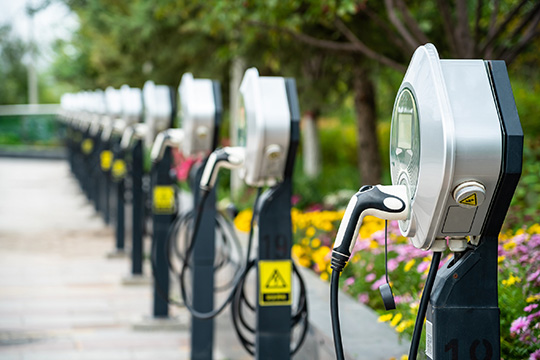
Groundbreaking NREL Study Identifies Infrastructure Needed To Support Electric Vehicle Charging Nationwide
Ambitious federal clean energy goals, including efforts to see EVs represent the majority of light-duty vehicle sales by 2030, could lead to 30 million–42 million EVs on the road by 2030. Now, a White House-commissioned study, referred to as the National Charging Network report, has estimated the number, type, and location of the infrastructure needed to support these vehicles. That infrastructure will form the backbone of the country's next great public works project: nationwide access to EV charging.
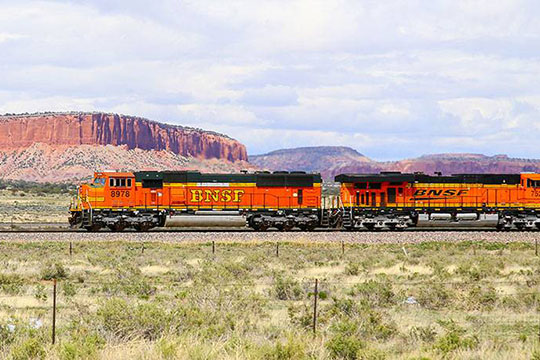
World's First Comprehensive, Open-Source Software for Freight Rail Decarbonization Released to the Public
North America's largest freight railroads have committed to slashing their greenhouse gas emissions 40% by 2030—and a new tool developed by NREL researchers will lay the tracks for their work. Researchers recently released the Advanced Locomotive Technology and Rail Infrastructure Optimization System (ALTRIOS) in open-source formats available to all. It is the world's first fully integrated, open-source software designed for exploring cost-effective, permanent decarbonization of the rail industry.
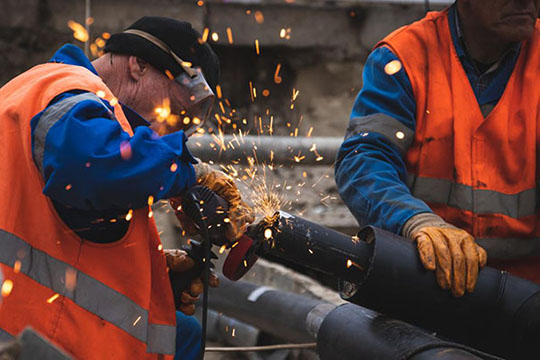
Ukraine Fights To Build More Resilient, Renewable Energy System in Midst of War
NREL researchers are part of a team working with Ukraine to increase its energy system’s resilience by integrating more renewables into the country’s energy mix. The team expanded the data set underlying NREL’s PVWatts® Calculator and translated it into Ukrainian, enabling the tool to be used by the country to evaluate solar projects and estimate the energy output from solar installations at a more granular level. Solar projects in Ukraine could alleviate interruptions in power supply.
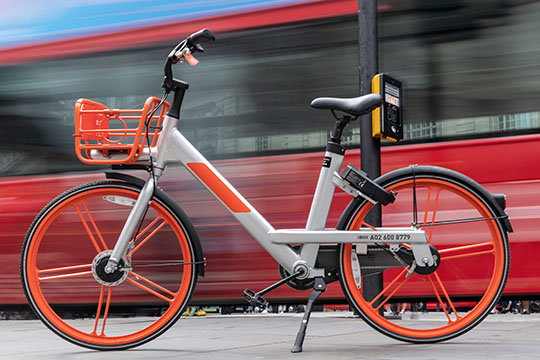
Nation's Largest E-Bike Pilot Program Identifies Energy, Emissions, and Mobility Behavior Impacts
The Colorado Energy Office, in partnership with NREL, recently concluded the largest e-bike pilot in the nation. The project included collecting holistic travel data via NREL's Open Platform for Agile Trip Heuristics (NREL OpenPATH) for nearly 2 years. NREL authored a key findings report based on the data, highlighting how e-bikes can serve unmet transportation needs while providing a cost-effective and energy-efficient alternative to other modes of transportation.
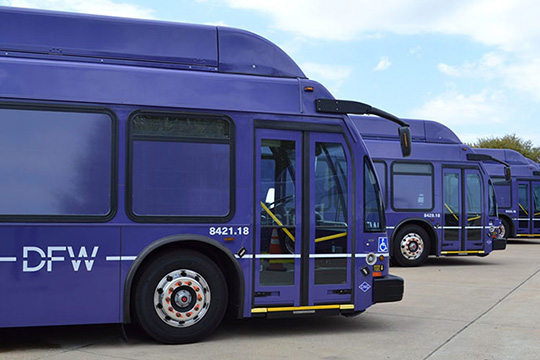
Analysis Tools Cut Through Complexity of Deploying and Operating Electric Buses at Airports
New simulation and modeling tools are helping Dallas Fort Worth International Airport—and likely other airports in the future—make informed decisions about bus fleet electrification. Analysis results can help transportation operators design and develop optimized electric bus deployment and operational strategies. These NREL-developed tools stem from the U.S. Department of Energy (DOE)-funded Athena project, which used high-performance computing to simulate the impacts of emerging mobility technologies to improve the efficiency of transportation hubs while minimizing capital costs and emissions.
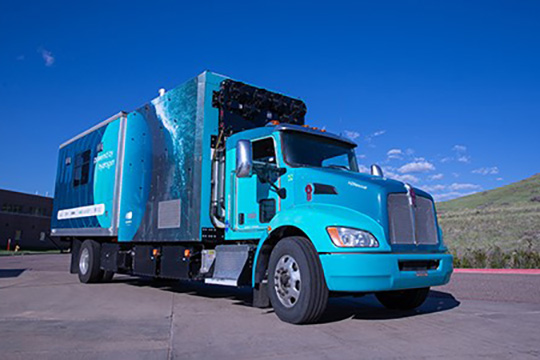
NREL Hosts Demonstration of Zero-Emissions Emergency Relief Vehicle Powered by Hydrogen
NREL hosted a demonstration of the H2Rescue vehicle—a first-of-its-kind hydrogen fuel cell-powered emergency relief truck. The DOE-led project includes a feasibility study and the development of a robust demonstration plan to ensure that the truck meets the needs of users in the emergency management field. The vehicle ultimately informs the DOE H2@Scale initiative's research and development to leverage medium- and heavy-duty transportation applications.

Colorado Shows Eagerness for Sustainable Aviation
The Colorado Division of Aeronautics is partnering with NREL to study opportunities to make next-generation aviation more accessible, efficient, and sustainable statewide. NREL will lead technical analysis, ultimately providing infrastructure investment recommendations to reduce costs, environmental impacts, and transit inequity on a site-by-site basis. The study is focused on finding the most practical solutions to reduce emissions, improve transit, and support the state's economy.
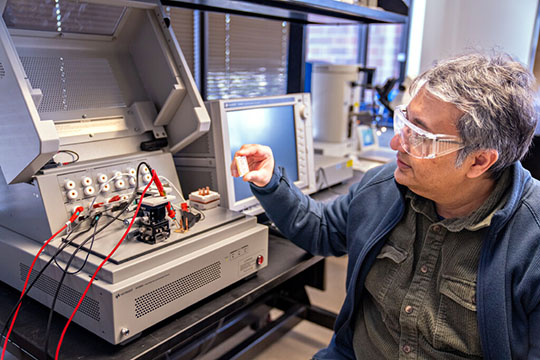
NREL's Smart, Wireless Gallium Oxide Power Module Will Push the Boundaries of Power Conversion
Faisal Khan, NREL's chief researcher for power electronics, is leading a transformational project to revolutionize the power electronics systems within EVs and for high-power, high-voltage, industrial-scale power conversion. How? With a smart, rugged, and wireless gallium oxide power module specifically designed to be attractive to industry adopters. NREL is poised to become a one-stop shop capable of fabricating the entire module in-house.
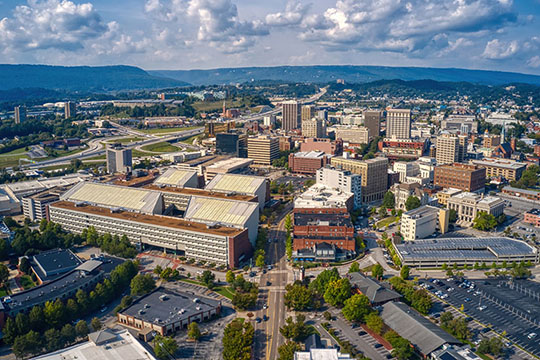
Chattanooga Digital Twin Project Signals Possibility of Nationwide Traffic Applications
For 4 years, NREL and Oak Ridge National Laboratory researchers have partnered with the city of Chattanooga, Tennessee, to reduce congestion using a "digital twin" of the city's traffic conditions. By optimizing traffic signals and applying high-performance computing strategies, researchers eased congestion by up to 32% citywide. Now, the partnership has resulted in a transferrable traffic mitigation framework capable of powering efforts to reduce traffic congestion nationwide.
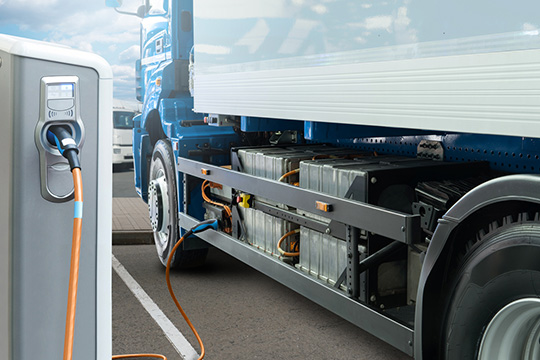
NREL Collaborates With Volvo Group To Chart Course to Commercial Vehicle Decarbonization
NREL transportation researchers joined forces with Volvo Group to chart the course toward a zero-emission future for medium- and heavy-duty vehicles. The industry/research team mapped the opportunity space as well as the requirements for various technologies. Battery-electric vehicles and hydrogen fuel cell electric vehicles running on clean hydrogen are emissions-free options, while sustainable liquid fuels offer opportunities to reduce emissions, particularly for legacy internal combustion engine vehicles.
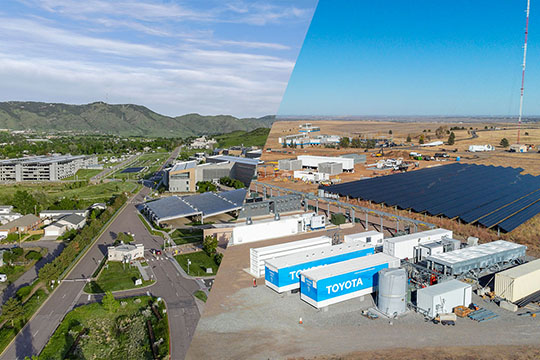
Inflation Reduction Act Invests $150 Million in NREL Projects
NREL will begin work on a series of additions and improvements to two of its campuses, made possible by $150 million in funding provided by the Inflation Reduction Act of 2022. The funding will support the construction of new facilities as well as renovations to advance the science of sustainable transportation and support the integration and optimization of energy systems required to decarbonize the U.S. economy and increase research competitiveness.
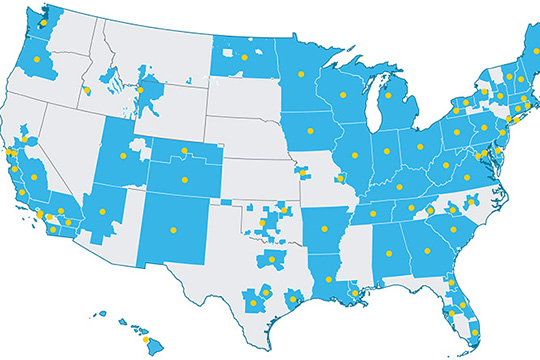
Clean Cities Thrives for 30 Years as Model for Collaborative Technology Deployment
A long-standing federal effort to decarbonize transportation proves how advanced technologies can make meaningful, real-world impacts by intertwining national goals and initiatives with local, community-based actions. A new NREL report documents how the innovative model built over the past 30 years by the DOE-funded Clean Cities Coalition Network can serve as a model for other federal efforts, demonstrating how federal programs can successfully deploy new technologies through long-term, multidirectional stakeholder engagement.

Nine Remote and Island Communities To Improve Energy Resilience Through Energy Transitions Initiative Partnership Project
DOE's Vehicle Technologies Office welcomed nine remote and island communities to the Energy Transitions Initiative Partnership Project (ETIPP). The communities have proposed projects that engage in energy planning and explore renewable energy technologies, including EV infrastructure, geothermal energy, hydropower, microgrids, solar power, tidal power, and wind power. These communities join 23 communities across the country that are already working with ETIPP to transition their energy systems toward renewable and resilient technologies.
Get To Know Our Team: Ken Kelly

A conversation with NREL's Ken Kelly, chief engineer for commercial vehicle electrification.
What does your research focus on?
My current focus is on the electrification of commercial vehicles—trucks and buses—and especially helping industry partners assess what it would take to transition their fleets from diesel to zero-emission vehicles and infrastructure.
Can you share a defining moment in your research career?
I am lucky to have had quite a few opportunities and defining moments at NREL. I've led national alternative fuel vehicle emission studies. I worked with Oshkosh to develop the first prototype for a hybrid-electric refuse hauler. I spent 2 years in Hawaii to lead the Hawaii Clean Energy Initiative, and then later, I developed the Sustainable Energy for Remote Island Grids project in Indonesia. Of course, being appointed chief engineer for commercial vehicle electrification has been a high point, too.
What piece of research are you most proud of conducting?
It's been an amazing journey—I joined the laboratory in 1991, when it was known as the Solar Energy Research Institute, or SERI. I think the most rewarding aspect has been all the people I have worked with over the years. I've learned from them all, while mentoring and guiding a few, developing industry partnerships, and helping organizations throughout the country achieve their technology and decarbonization goals.
What single mobility challenge would you say we need to prioritize in the next 5 years?
Moving quickly and, at the same time, most effectively to decarbonize commercial vehicles. There is a particular need to help determine which strategies are the right fit for particular commercial vehicle applications—and that involves looking at the trade-offs between battery-electric and hydrogen fuel cell vehicles, developing ubiquitous charging and fueling infrastructure, and addressing the resiliency and reliability aspect for infrastructure. These are all areas where we at NREL can have a real impact in guiding progress on a national scale.
Must Reads
NREL Study Charts a Road Map Toward Vehicle Electrification Goals
The Biden-Harris administration has set aggressive clean energy goals, including leveraging American manufacturing to ensure that EVs represent half of all new car sales by 2030. Meeting that goal could result in 30–42 million light-duty EVs on the road by the end of the decade. A seminal study by NREL in collaboration with the Joint Office of Energy and Transportation and the DOE Vehicle Technologies Office has quantified the estimated number, type, location, and cost of the chargers needed nationwide to ensure convenient, reliable, and affordable charging for all Americans. Read The 2030 National Charging Network: Estimating U.S. Light-Duty Demand for Electric Vehicle Charging Infrastructure to uncover their findings, including how the analysis accounts for the many physical and behavioral factors affecting EV charging infrastructure needs.
Alternative Fuels Data Center Provides a Snapshot of Electric Vehicle Charging Infrastructure Growth
EV charging infrastructure continues to rapidly change and grow, and DOE's Alternative Fuels Data Center (AFDC) is keeping pace. Each quarter, AFDC and NREL publish a snapshot of the state of EV charging infrastructure by charging level, network, and location, in addition to benchmarks against 2030 infrastructure goals. Read the EV Charging Infrastructure Trends from the Alternative Station Locator: First Quarter 2023 report to discover more about the quickly evolving landscape.
Advanced Research on Integrated Energy Systems Annual Report Highlights an Impactful Year of Research
Advanced Research on Integrated Energy Systems (ARIES) is the nation's most advanced platform for energy system integration research and validation, designed to support and accelerate the nation's transition to a decarbonized electric grid. As the energy system undergoes dramatic transformations, the ARIES fiscal year 2022 annual report benchmarked major advances, investments, partnerships, and more. Check out the report and webpage to discover how ARIES is advancing transportation, from heavy-duty hydrogen fueling to behind-the-meter storage and grid impacts of EV charging.
Did You Know?
EVs collect and store energy from the grid to use when driving. This stored energy can be used to support the grid through vehicle-to-everything (V2X) connectivity, such as vehicle-to-building (V2B) or vehicle-to-grid (V2G), when the vehicle is not being driven. V2X has the potential to power everyday electricity needs, including tools at off-grid work sites, buildings experiencing electrical outages, and camping appliances.
In a new episode of On the Go: An On-Road Transportation Podcast with Clean Cities, NREL researchers Jesse Bennett and Andrew Meintz discuss V2X technologies and applications, including vehicle-to-load, V2B, and V2G integration; the near-term outlook for these uses; and technical challenges and barriers that will need to be overcome for broader use of V2X. You can also find this episode on Spotify, Apple Podcasts, or Google Podcasts.
In the News
What It Would Take for Electric Vehicles To Help Power the Grid
Scientific American interviews Andrew Meintz
Under a new proposal, all new EVs sold in California starting in 2027 would need the ability to both store and send power. However, there are many obstacles, including differences in charger technologies, lack of regulatory incentives, and a lack of widespread danger-prevention standards for V2G applications.
Colorado Is Poised To Set the Nation's First Standards for Green Hydrogen. Will the
Federal Government Follow Suit?
Colorado Public Radio interviews Keith Wipke
Green hydrogen has many benefits over other fuels, making hydrogen an ideal replacement for fossil fuels in long-haul trucks, ships, and aircraft. Colorado lawmakers recently amended a bill to include the nation's first-ever clean hydrogen standards while leaving enough flexibility to allow the industry to grow.
Seven Major Automakers, Including GM, Stellantis, and Honda, Join To Create U.S. Charging
Network
CNN features NREL's 2030 National Charging Network report
General Motors, BMW Group, Honda, Hyundai, Kia, Mercedes-Benz, and Stellantis are creating a joint venture that will build out an EV fast-charging network of at least 30,000 chargers in the United States and Canada to make electric vehicles more attractive to consumers.
Study Reveals How Many Millions of Chargers the U.S. Will Need To Go Fully Electric
autoevolution features NREL's 2030 National Charging Network report
An NREL analysis of the chargers needed to support the projected U.S. fleet of 30 million–42 million EVs on the road by 2030 charts a plan for a charging network that is convenient, affordable, reliable, and equitable to enable a future where everyone can ride and drive electric.
Jet Fuel From Agricultural Waste – Featuring Southwest Airlines
EARTH With John Holden interviews Mike Himmel
Today's airline industry uses about 21 billion gallons of jet fuel annually. If commercialized, new technology from Sustainable Aviation Fuel From [i] Renewable Ethanol (SAFFiRE) could process some of the 400 million tons of corn stover produced by the United States each year to deliver over 10 billion gallons of sustainable aviation fuel.
Share

